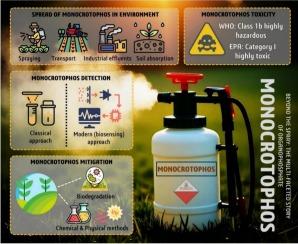Tracking monocrotophos pollution: From environmental spread to biosensor-based detection and remediation
IF 4
1区 农林科学
Q2 BIOCHEMISTRY & MOLECULAR BIOLOGY
引用次数: 0
Abstract
Monocrotophos, a widely used organophosphate insecticide, has long stood at the intersection of agricultural utility and environmental hazard. This review delves beyond its routine application to uncover the broader implications of monocrotophos pollution and its persistence in agroecosystems. From its physicochemical properties and usage patterns to its contamination of soil, water, and food, monocrotophos pollution continues to pose serious ecological and human health challenges. We explore classical and emerging detection methods, highlighting the promise of biosensors for rapid, on-site residue monitoring. Furthermore, the review discusses various remediation strategies, with a focus on bioremediation using microbial systems for sustainable degradation. This review underscores the urgent need for coordinated action in pollution monitoring, detection, and mitigation. Taken together, the story of monocrotophos is not just about a pesticide, but a reflection of the delicate balance between agricultural advancement and environmental responsibility.

单效磷污染追踪:从环境扩散到基于生物传感器的检测和修复
一效磷是一种广泛使用的有机磷杀虫剂,长期以来一直处于农业用途和环境危害的交叉点。这篇综述深入研究了它的常规应用,揭示了单效磷污染及其在农业生态系统中的持久性的更广泛的影响。从其理化性质和使用方式到其对土壤、水和食物的污染,单效磷污染继续对生态和人类健康构成严重挑战。我们探索了经典的和新兴的检测方法,强调了生物传感器对快速、现场残留物监测的承诺。此外,本文还讨论了各种修复策略,重点介绍了利用微生物系统进行可持续降解的生物修复。这一综述强调了在污染监测、检测和缓解方面采取协调行动的迫切需要。综上所述,单效磷的故事不仅仅是一种农药,它还反映了农业发展与环境责任之间的微妙平衡。
本文章由计算机程序翻译,如有差异,请以英文原文为准。
求助全文
约1分钟内获得全文
求助全文
来源期刊
CiteScore
7.00
自引率
8.50%
发文量
238
审稿时长
4.2 months
期刊介绍:
Pesticide Biochemistry and Physiology publishes original scientific articles pertaining to the mode of action of plant protection agents such as insecticides, fungicides, herbicides, and similar compounds, including nonlethal pest control agents, biosynthesis of pheromones, hormones, and plant resistance agents. Manuscripts may include a biochemical, physiological, or molecular study for an understanding of comparative toxicology or selective toxicity of both target and nontarget organisms. Particular interest will be given to studies on the molecular biology of pest control, toxicology, and pesticide resistance.
Research Areas Emphasized Include the Biochemistry and Physiology of:
• Comparative toxicity
• Mode of action
• Pathophysiology
• Plant growth regulators
• Resistance
• Other effects of pesticides on both parasites and hosts.

 求助内容:
求助内容: 应助结果提醒方式:
应助结果提醒方式:


